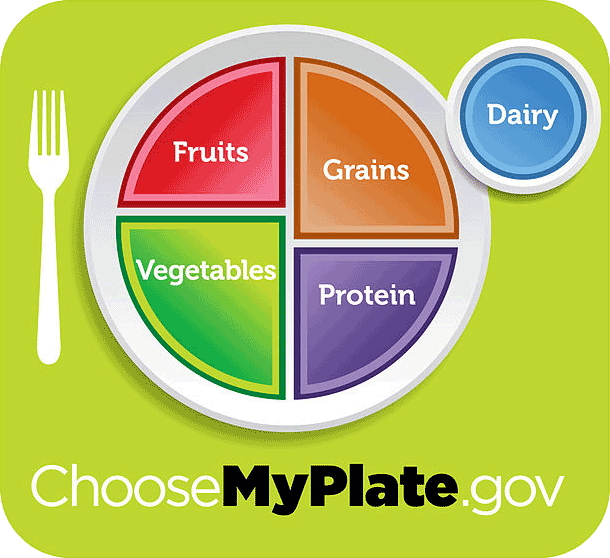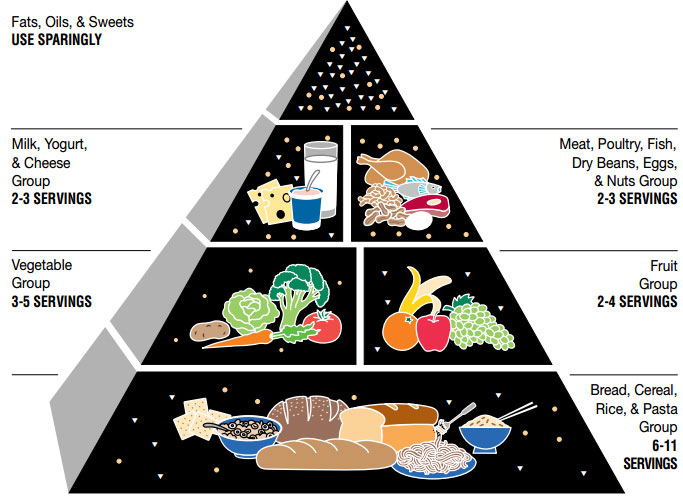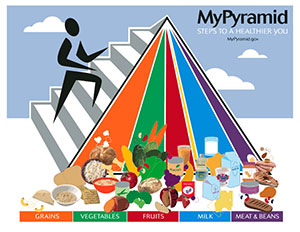Food Pyramids & Food Politics
Of the many governmental agencies that exist, the two that have a direct impact on our food chain are the United States Department of Agriculture (USDA) and the Federal Drug Administration (FDA). Let's take a look at what these two agencies are responsible for:
The USDA
The USDA is a department of the government headed by the Secretary of Agriculture. It is responsible for:
- Developing and executing governmental policies to help the farming and agricultural industries. It also assists rural communities with financial funding.
- Providing dietary advice and recommendations to the general public.
- Promoting agricultural trade & production.
- Working closely with the FDA to ensure food safety.
The FDA
The FDA is a section of the U. S. Department of Health & Human Services responsible for:
- Protecting public health by ensuring the safety of prescription and non-prescription drugs, nutritional supplements, cosmetics, veterinary products, radiation-emitting products, medical devices, biological products, tobacco products, and other items.
- Enforcing laws with regard to disease control.
FDA: Failure to protect our food chain...
Conflict Of Interest
|
Unfortunately for the American people, the USDA and FDA have had conflicting priorities right from the start. On one hand, they are tasked with protecting the public's health. But on the other hand, they also protect the interests of powerful for-profit food and pharmaceutical industry giants. It is not possible to succeed at doing both.
The government receives substantial financial contributions from powerful food industry lobbyists. These lobbyists would never provide such funding if the government educated the public on how unhealthy their processed and refined foods are, and on the toxic nature of many ingredients in these foods. Educating the public on excluding these foods from their diet would seriously damage the profits of the 5 food corporations that control most of our food chain.
A politician will always protect whatever produces profit from their state. A Senator from a meat-producing state will always protect the cattle industry, even though that industry engages in factory-farming practices considered so cruel and inhumane that they are banned in other civilized countries.
- What is factory farming & why is it banned in other countries?
- 7 reasons factory-farmed meat is dangerous for your health
A Senator from a dairy-producing state will do the same, and never share with the public studies that now link the increase in osteoporosis and other bone-related diseases to pasteurized dairy products. They will not share that pasteurization destroys the nutrients in milk, contain antibiotic residue, can contain growth hormones and medicated additives, and are fortified with synthetic vitamins.
Pasteurized dairy & why you should avoid it...
National Cancer Inst. & Nat'l Inst. of Health |
The public policies of an individual state will always reflect what the Senator wants to protect, and what they protect is often based on the funding they receive. Why is this a problem? Because this directly affects how food policies are written. Even if independent organizations provide conclusive studies that eating a certain food type (or eating it in large quantities) is detrimental to public health, a Senator will swiftly work with lobbyists from that food industry to ensure there is no mention of decreasing that food in the American diet.
Medical research organizations such as the NCI and NIH estimate that 35% of all cancers can be prevented by diet, yet these organizations only devote 2-3% of their entire research budget to finding out why, and they provide no education to the public on this fact.
The USDA Food Pyramids
Even though the USDA has other responsibilities, let's take a look at their role in providing dietary advice and recommendations to the general public.
The "MyPlate" - Today's Dietary Guidelines
 In June, 2011, MyPlate replaced MyPyramid as the government's primary food group symbol. It was designed to be a simple and easy-to-understand version of the pyramid, and shows a circle divided into four brightly-colored sections.
In June, 2011, MyPlate replaced MyPyramid as the government's primary food group symbol. It was designed to be a simple and easy-to-understand version of the pyramid, and shows a circle divided into four brightly-colored sections.
MyPlate is a significant improvement over previous pyramids, with vegetable and fruits taking up half of the plate (finally!). Proteins and grains are each given a 1/4 of the plate. But let's take a look at the downside:
MyPlate - Intentionally Vague
The dietary guidelines are also intentionally vague. The words "reduce sugar, sodium, and refined grains" does not help the American consumer understand just how much they should consume of these foods, and what they should avoid entirely.
- Should now limit my daily Oreos to 5 instead of 10?
- How about 1 packet of M&Ms instead of 2. Easy fix!
- What about eating sugar cookies instead of fried donuts?
- Is pasta just once every day ok?
Well no... not at all...
Let's look at some other questions that MyPlate does not answer:
- I have my portion of meat for the day. It is factory-farmed meat, and contains hormones, medicated additives, and antibiotics. But that's ok, right? ...Read more
- I have a lovely plate of fruits, but they are not organic and have been sprayed with pesticides that are illegal in other countries. These pesticides have been directly linked to cancer, ADD, autism, neurological disorders, childhood leukemia, and other chronic diseases. But that's ok, right? ...Read more
- Even though this whole grain bread contains 30 other unpronounceable chemical and artificial ingredients, it's still got the words "whole grains" in the ingredient list. So that's ok, right? ...Read more
- Is caffeine and alcohol good for me? There is no mention that they are bad, so I assume I can have them in whatever quantities I want, right? ...Read more
- All the veggies on my plate are genetically modified, and studies in other countries have conclusively shown GMOs have caused organ damage, infertility, and premature death in animals. The studies don't seem to be publicized in the US and no long-term studies on how GMOs affect humans exist. But that's ok, right? ...Read more
- This food says it is "healthy" and "natural" but the ingredient list is really long and full of chemicals. But it is still healthy and natural, right? ...Read more
Is there any guidance provided in how to read food ingredient labels and recognize the difference between healthy and unhealthy ingredients? No... no help there either.
You get the picture. What good is it to tell the public to eat more "whole grains" but not educate them on the subject of what grains are and how to distinguish the good from the bad, or that refined grains should be avoided? What is a whole grain vs. a refined grain? What about whole wheat? What about wheat grain and gluten? In short, Americans have been left to reach their own conclusions on many of their questions.
MyPlate - Have You Heard Of It?
If you ask the average person on the street their opinion on MyPlate, you will probably get a blank face. Why? Because it is not promoted! Little to no money from the multi-trillion dollar annual governmental budget is spent on promoting the government's own MyPlate.
How often have you seen a government-sponsored commercial promoting juicy whole fruits or fresh leafy greens? How about whole grains or nuts? In a nation where the word "natural food coloring" can translate to a combination of over 50 different chemicals, the average consumer is thoroughly confused about whether the product in their hands is healthy or unhealthy. But in the absence of education, the food corporations quickly step up to the plate.
The Impact of These Pyramids & Plates
Unfortunately, the impact of the USDA nutritional guidelines is far-reaching, influencing all government nutrition programs, food marketing and labeling, and also forms the basis of dietary advice and training for:
- The Medical Profession (doctors & hospitals)
- Clinical Nutritionists & Registered Dietitians
- School Lunch Program Creators
- Medical insurance Companies
The education of Certified Nutritionists and Registered Dietitians is based on guidelines established by the government, and these guidelines form the basis of their nutritional advice when working with clients unless they have expanded their training outside the scope of government accredited educational institutions. To their credit, some are doing just that as they have recognized the serious shortcomings of government-endorsed education on nutrition.
Along with the pharmaceutical-controlled healthcare industry, the MyPyramid and MyPlate guidelines have helped pave the path toward skyrocketing rates of obesity and other chronic diseases in America today.
Harvard Goes It Alone - The Harvard Food Pyramid
In recognition of the lack of guidance and education for the latest USDA dietary recommendations, Harvard School of Public Health's Dept. of Nutrition has released their own version of a healthy eating pyramid that puts whole grains, vegetables and fruits, and healthy fats in the base. Red meat, butter, soda, sweets, refined grains, and salt are in the pyramid, but recommended in very small quantities at the tip.
RELATED ARTICLES
- Why choose natural medicine
- Our food supply - Corruption & failure
- The FDA - Failure on a mass scale
- The toxic US healthcare system
- A medicated nation
- The fatal cost of medical errors
- Nutritional "experts"?
- Food pyramids & food politics
- Global repercussions of American food
- Vaccinations: The pros & cons
- Your immune system & how it works
- The Dirty Dozen: What they are & how to avoid them
- Why our pets are getting sicker
- Raising children naturally





